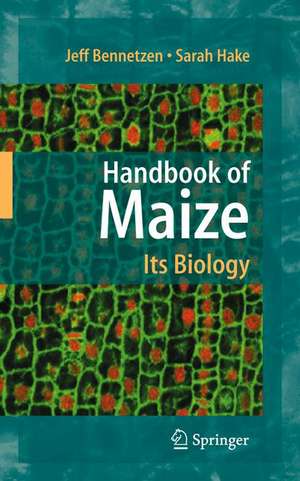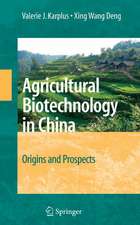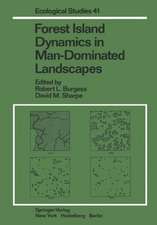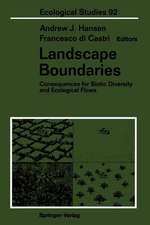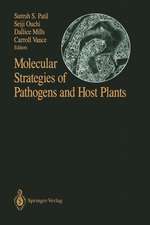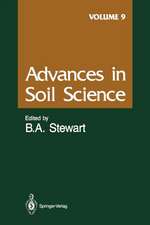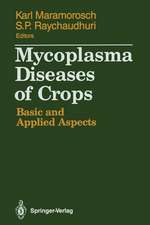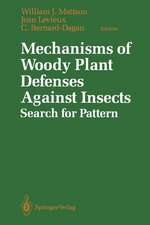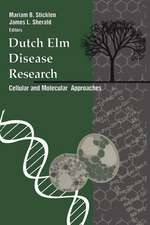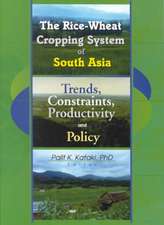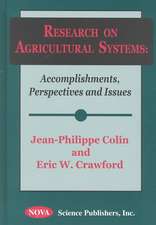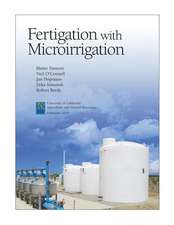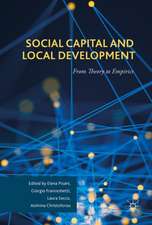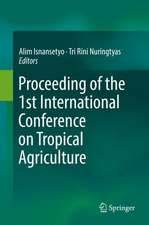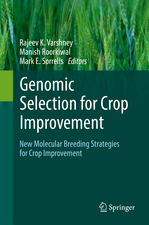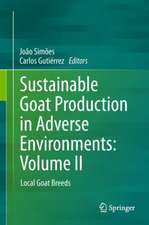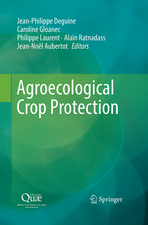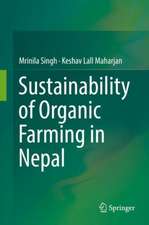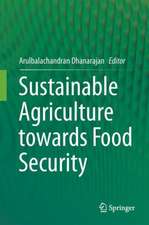Handbook of Maize: Its Biology
Editat de Jeff L. Bennetzen, Sarah C. Hakeen Limba Engleză Hardback – 11 dec 2008
Beyond its major agricultural and economic contributions, maize has been a model species for genetics since it was the first plant to have a genetic map, initially published by Emerson and colleagues in 1935. Such central genetic phenomena as telomeres, nucleolar organizers, transposable elements and epigenetic gene regulation were all discovered first in maize, and later found to be universal eukaryotic genome properties. These central genetic contributions continue, including the characterization of the structure and evolution of complex plant genomes.
Among plant science researchers, maize has the second largest and most productive research community, trailing only the Arabidopsis community in scale and significance. At the applied research and commercial improvement levels, maize has no peers in agriculture, and consists of thousands of contributors worthwhile. A comprehensive book on the biology of maize has not been published. In 1999, Peterson and Bianchi published"Maize Genetics and Breeding in the 20th Century", a highly personal account of the last hundred years of maize genetics". In 1968 and 1996, two editions of "The Mutants of Maize" were published, and these have been landmark books showing and briefly describing the contemporary genetic and molecular status of the maize mutant collection, a collection unsurpassed for any other organism, animal or plant. In the last seven years, there has been no publication targeting maize genetics, genomics or overall biology. Hence, a modern and comprehensive volume on the status (and future) of maize as a species for biological study is highly warranted.
Handbook of Maize: Its Biology centers on the past, present and future of maize as a model for plant science research and crop improvement. The book includes brief, focused chapters from the foremost maize experts and features a succinct collection of informative images representing the maize germplasm collection.
| Toate formatele și edițiile | Preț | Express |
|---|---|---|
| Paperback (2) | 1060.89 lei 38-44 zile | |
| Springer – 22 noi 2010 | 1060.89 lei 38-44 zile | |
| Springer – 5 dec 2010 | 1241.10 lei 43-57 zile | |
| Hardback (2) | 1098.83 lei 38-44 zile | |
| Springer – 14 ian 2009 | 1098.83 lei 38-44 zile | |
| Springer – 11 dec 2008 | 1240.93 lei 43-57 zile |
Preț: 1240.93 lei
Preț vechi: 1513.33 lei
-18% Nou
Puncte Express: 1861
Preț estimativ în valută:
237.53€ • 258.09$ • 199.65£
237.53€ • 258.09$ • 199.65£
Carte tipărită la comandă
Livrare economică 21 aprilie-05 mai
Preluare comenzi: 021 569.72.76
Specificații
ISBN-13: 9780387794174
ISBN-10: 0387794174
Pagini: 587
Ilustrații: IX, 587 p.
Dimensiuni: 155 x 235 x 28 mm
Greutate: 1.11 kg
Ediția:2009
Editura: Springer
Colecția Springer
Locul publicării:New York, NY, United States
ISBN-10: 0387794174
Pagini: 587
Ilustrații: IX, 587 p.
Dimensiuni: 155 x 235 x 28 mm
Greutate: 1.11 kg
Ediția:2009
Editura: Springer
Colecția Springer
Locul publicării:New York, NY, United States
Public țintă
ResearchCuprins
Vegetative Shoot Meristems.- Development of the Inflorescences.- The Maize Floral Transition.- The Maize Male Gametophyte.- The Maize Megagametophyte.- Patterning of the Maize Embryo and the Perspective of Evolutionary Developmental Biology.- Kernel Biology.- The Maize Root System: Morphology, Anatomy, and Genetics.- Axial Patterning of the Maize Leaf.- Cell Biology of Maize Leaf Development.- Light Signal Transduction Networks in Maize.- Maize Disease Resistance.- Virus Resistance.- Genetics and Biochemistry of Insect Resistance in Maize.- Chilling Stress in Maize Seedlings.- Drought Tolerance in Maize.- Responses to Oxygen Deprivation and Potential for Enhanced Flooding Tolerance in Maize.- Maize Al Tolerance.- Maize Under Phosphate Limitation.- Agronomic Traits and Maize Modifications: Nitrogen Use Efficiency.- Seed Phosphate.- Seed Starch Synthesis.- Heterosis.- Increasing Yield.- The Illinois Long-Term Selection Experiment, Related Studies, and Perspectives.- QTL for Agronomic Traits in Maize Production.- The Mexican Landraces: Description, Classification and Diversity.- Production, Breeding and Process of Maize in China.
Recenzii
From the reviews:
“The book shapes the current bigger picture of the maize plant and puts its biology back into the minds of maize geneticists and breeders. … High-quality figures, good explanatory colour diagrams and informative tables support the excellent, technically flawless text. The book is delightful to read … which is supplemented with a large selection of literature references. … very useful for teachers, students and non-specialists, in addition to maize researchers and breeders as well. … it is an excellent book, produced at the right time.” (Ralf G. Kynast, Annals of Botany, Vol. 109 (7), June, 2012)
“The book shapes the current bigger picture of the maize plant and puts its biology back into the minds of maize geneticists and breeders. … High-quality figures, good explanatory colour diagrams and informative tables support the excellent, technically flawless text. The book is delightful to read … which is supplemented with a large selection of literature references. … very useful for teachers, students and non-specialists, in addition to maize researchers and breeders as well. … it is an excellent book, produced at the right time.” (Ralf G. Kynast, Annals of Botany, Vol. 109 (7), June, 2012)
Notă biografică
Jeff Bennetzen, Ph.D. is the Norman and Doris Giles Professor of Molecular Biology and Functional Genomics at the University of Georgia, and is also a Georgia Research Alliance Eminent Scholar. He has studied the structure and evolution of the maize genome for the last 28 years.
Sarah Hake, Ph.D. is the Center Director of the Plant Gene Expression Center of the United States Department of Agriculture – Agricultural Research Service and University of California, Berkeley. She is also an adjunct Professor in the Department of Plant and Microbial Biology at U. C. Berkeley. She has worked on maize throughout her scientific career.
Sarah Hake, Ph.D. is the Center Director of the Plant Gene Expression Center of the United States Department of Agriculture – Agricultural Research Service and University of California, Berkeley. She is also an adjunct Professor in the Department of Plant and Microbial Biology at U. C. Berkeley. She has worked on maize throughout her scientific career.
Textul de pe ultima copertă
Maize is one of the world’s highest value crops, with a multibillion dollar annual contribution to agriculture. The great adaptability and high yield of maize as a food, feed and forage crop have led to its production on a massive scale, with acreage expanding at the expense of other crops. Maize has developed in its non-food usage, comprising a major source of ethanol for fuel in the United States. In addition, maize has occupied center stage in the transgenic plant controversy, serving as one of the first food crops with commercialized transgenic varieties. The release of the genome sequence of maize in 2008 will indicate the structure and gene content of the first average-size plant genome and will be the most complex genome sequenced from any organism to date.
Beyond its major agricultural and economic contributions, maize has been a model species for genetics since it was the first plant to have a genetic map, initially published by Emerson and colleagues in 1935. Such central genetic phenomena as transposable elements, nucleolar organizers, telomeres and epigenetic gene regulation were discovered first in maize, and later found to be universal eukaryotic genome properties. These key genetic contributions continue, including taking the lead in the characterization of the evolution of the highly unstable genomes so common in flowering plants.
Among plant science researchers, maize has the second largest research community, trailing only the Arabidopsis community. Despite the size and scope of this community, a comprehensive book on the biology of maize – targeting genetics, genomics or overall biology - has not been published. Hence, a modern and comprehensive volume on the status (and future) of maize as a species for biological study is highly warranted.
Handbook of Maize: Its Biology centers on the past, present and future of maize as a model for plant science research and crop improvement. The book includes brief,focused chapters from the foremost maize experts and features a succinct collection of informative images representing the maize germplasm collection.
Jeff Bennetzen, Ph.D. is the Norman and Doris Giles Professor of Molecular Biology and Functional Genomics at the University of Georgia, and is also a Georgia Research Alliance Eminent Scholar. He has studied the structure and evolution of the maize genome for the last 28 years.
Sarah Hake, Ph.D. is the Center Director of the Plant Gene Expression Center of the United States Department of Agriculture – Agricultural Research Service and University of California, Berkeley. She is also an adjunct Professor in the Department of Plant and Microbial Biology at U. C. Berkeley. She has worked on maize throughout her scientific career.
Beyond its major agricultural and economic contributions, maize has been a model species for genetics since it was the first plant to have a genetic map, initially published by Emerson and colleagues in 1935. Such central genetic phenomena as transposable elements, nucleolar organizers, telomeres and epigenetic gene regulation were discovered first in maize, and later found to be universal eukaryotic genome properties. These key genetic contributions continue, including taking the lead in the characterization of the evolution of the highly unstable genomes so common in flowering plants.
Among plant science researchers, maize has the second largest research community, trailing only the Arabidopsis community. Despite the size and scope of this community, a comprehensive book on the biology of maize – targeting genetics, genomics or overall biology - has not been published. Hence, a modern and comprehensive volume on the status (and future) of maize as a species for biological study is highly warranted.
Handbook of Maize: Its Biology centers on the past, present and future of maize as a model for plant science research and crop improvement. The book includes brief,focused chapters from the foremost maize experts and features a succinct collection of informative images representing the maize germplasm collection.
Jeff Bennetzen, Ph.D. is the Norman and Doris Giles Professor of Molecular Biology and Functional Genomics at the University of Georgia, and is also a Georgia Research Alliance Eminent Scholar. He has studied the structure and evolution of the maize genome for the last 28 years.
Sarah Hake, Ph.D. is the Center Director of the Plant Gene Expression Center of the United States Department of Agriculture – Agricultural Research Service and University of California, Berkeley. She is also an adjunct Professor in the Department of Plant and Microbial Biology at U. C. Berkeley. She has worked on maize throughout her scientific career.
Caracteristici
A modern and comprehensive volume on the status and future of maize as a species for biological study Comprised of brief, focused chapters from the foremost maize experts across a range of disciplines
